
 |
![]()
Profile of Moderator and Panelists
| Moderator: | Dr. Satoru Nishiyama |
| Panelist: | Dr. Hans E Pettersson |
| Panelist: | Mr. David Lynam |
| Panelist: | Dr. Ichiro Uchiyama |
| Panelist: | Dr. Kazuhisa Ogawa |
Abstract of Lectures and Powerpoint Slides
Satoru Nishiyama
Professor Emeritus at Hiroshima University
| 1930: | Year of birth |
| 1953: | Graduated from Department of Psychology, Faculty of Education at Hiroshima University |
| 1955: | Finished his master's degree at Graduate School of Education, Hiroshima University |
| 1957: | Assistant for Faculty of Education at Hiroshima University |
| 1971: | Assistant Professor for Faculty of Education at Hiroshima University |
| 1977: | Professor for Faculty of Education at Hiroshima University |
| 1987: | Awarded doctorate in Letters from Hiroshima University |
| 1992: | Head of Faculty of School Education at Hiroshima University |
| 1994: | Professor Emeritus at Hiroshima University |
Specialty: Traffic Psychology
Publications: Jidosha Kyoshu no Sinri-gaku < Education Psychology on Driving Instruction > (Keiseisha)
西山 啓
広島大学名誉教授 | |
| 1930年 | 生まれ |
| 1953年 | 広島大学教育学部心理学科卒業 |
| 1955年 | 広島大学大学院教育学研究科修士課程修了 |
| 1957年 | 広島大学教育学部助手 |
| 1971年 | 広島大学教育学部助教授 |
| 1977年 | 広島大学教育学部教授 |
| 1987年 | 広島大学文学博士学位取得 |
| 1992年 | 広島大学学校教育学部長 |
| 1994年 | 広島大学名誉教授 |
専門は交通心理学 著書は「自動車教習の教育心理学」(啓正社)等 | |
Hans Erik Pettersson
| Born | 1942 August 23 |
| Education | PhD 1993 (Psychology) |
| Professional experience |
University teacher at the University of Stockholm 1971 -1972 Researcher at Swedish National Road and Transport Research Institute 1973 - 1982 Researcher at National Swedish Defense Research Establishment 1983 - 1988. Researcher at Swedish National Road and Transport Research Institute 1989 - 1994. Research Director at Swedish National Road and Transport Research Institute 1995 - 2002 Research leader at Swedish National Road and Transport Research Institute 2003 - |
ハンス・エリック・ペタソン
| 生年月日 | 1942年8月23日 |
| 学位 | 1993年博士号取得(心理学) |
| 職歴 | 1971〜1972年 ストックホルム大学教員 1973〜1982年 スウェーデン国立道路交通研究所研究員 1983〜1988年 スウェーデン国立防衛研究所研究員 1989〜1994年 スウェーデン国立道路交通研究所研究員 1995〜2002年 スウェーデン国立道路交通研究所研究ディレクター 2003年〜 スウェーデン国立道路交通研究所研究リーダー |
David Lynam
Short biography
David Lynam is currently a Chief Research Scientist in the Safety Group at TRL. He has worked at TRL and the Department of Transport for 35 years, initially in transportation modelling and assessment of novel transport systems for both passengers and freight. He spent four years at the Department of Transport as a research manager, before returning to work on TRL's road safety programme in 1983. He was a member of the team developing the 1987 UK safety plan and the casualty reduction target for the year 2000, and also advised on the development of the casualty reduction target for 2010. During the 1990s, he managed the TRL Road Safety Division, and subsequently the TRL road and vehicle safety programme. He has detailed knowledge over a broad field of road safety research, and a wide experience of European safety issues. Particular interests: safety of road design, urban safety management, accident reduction measures, driver training, child safety, national road safety targets, and speed management.
デイビッド・ライナム
略歴
現在、イギリス交通研究所(TRL)安全グループの主任研究員。TRLと交通省で35年間勤務。最初は旅客と貨物のための新しい交通システムのモデル作成と評価を担当。交通省で4年間、研究マネージャーを務めた後、1983年にTRLに戻って道路交通安全計画に携わる。1987年イギリス安全計画作成および2000年の事故減少目標設定チームのメンバー。また2010年事故減少目標作成の顧問でもある。1990年代にはTRL道路交通安全部長を務めた後、TRL道路・車両安全計画を担当。道路安全研究の幅広い分野に精通し、ヨーロッパの安全性の問題について豊富な経験を持つ。中でも専門分野は道路設計の安全性、都市安全管理、事故減少の方法、運転教育、子供の安全確保、国家道路安全目標、スピード制御。
Ichiro Uchiyama
Assistant Professor of Faculty of Letters at Doshisha University
| 1956: | Year of Birth |
| 1980: | Graduated from Department of Psychology, Faculty of Letters, at Doshisha University |
| 1987: | Awarded his doctorate from Graduate School of Education and Human Development (the latter term of doctorate) at Nagoya University |
| 1988: | Full-time lecturer of Junior College of University of Shizuoka |
| 1994: | Full-time lecturer for Faculty of Letters at Doshisha University |
| 1995: | Assistant Professor for Faculty of Letters at Doshisha University |
Specialty: Traffic Psychology, Developmental and Educational Psychology
Publications: Shakai Shinri-gaku < Social Psychology > (Kenpakusha), etc
内山 伊知郎
同志社大学文学部助教授
| 1956年 | 生まれ |
| 1980年 | 同志社大学文学部心理学専攻卒業 |
| 1987年 | 名古屋大学大学院教育学研究科博士課程後期課程単位等認定 |
| 1988年 | 静岡県立大学短期大学部専任講師 |
| 1994年 | 同志社大学文学部専任講師 |
| 1995年 | 同志社大学文学部助教授 |
専門は交通心理学、発達・教育心理学
著書は「社会心理学」(建帛社)等
Kazuhisa Ogawa
DOB: April 23,1963| Age: | 40 years |
| Job: | Associate Professor Department of Language and Communication Faculty of Human and Social Environment HIROSHIMA INTERNATIONAL UNIVERSITY |
Major Field of Research: Traffic Psychology, Industrial Psychology
Education and Career:| 1986-1988 | Master course, Graduate school of Human Sciences. Osaka University |
| 1988-1990 | Doctor course, Graduate school of Human Sciences, Osaka University |
| 1990-2001 | Research Associate, Faculty of Human Sciences, Osaka University |
| 2001- | Associate Professor, Faculty of Human and Social Environment, Hiroshima International University |
Membership :
International Association of Applied Psychology(IAAP)
The Japan Association of Applied Psychology
The Japanese Association of Traffic Psychology
The Japanese Psychological Association
The Traffic Science Society of Osaka
etc.
小川 和久
広島国際大学人間環境学部言語・コミュニケーション学科助教授
| 1963年 | 生まれ |
| 1988年 | 大阪大学大学院人間科学研究科博士前期課程修了 |
| 1990年 | 大阪大学大学院人間科学研究科博士後期課程修了 |
| 1990年 | 大阪大学人間科学部助手 |
専門は交通心理学、産業心理学
著書は「交通安全学」(企業開発センター)等
Abstract
Human errors can be regarded as a part of human nature. The errors are the price man has to pay for his great flexibility and adaptive skill. Of course it creates great problems in systems where errors can have such disastrous consequences as in the road traffic system. In vision zero this has been taken care of by emphasizing the distribution of responsibility between the road users and the designers of the road traffic system. As long as the road users obey the regulation of the traffic system it's up to the system designers to design the system in such a way that human errors doesn't result in serious injuries.
It is however important to point out that although errors are a part of human nature and hardly are possible to eliminate, it is indeed possible to decrease the probability of errors to occur.
The most obvious means to influence road user behaviour are probably information and education. Pedagogical measures certainly are important and it seems as they have developed to bee more efficient in the last years. But the perhaps most important way to influence road user behaviour are by the preconditions for the behaviour the design of the technical components constitutes. It is therefore of outmost importance that the design of roads and vehicles are well adapted to the characteristics of man.
The conclusion that ought to be drawn is that a successful traffic safety work demands a very broad repertoire of measures. The road users must be given good education and training and the technical parts of the system must be adapted to the characteristics of man in order to minimize the probability of human errors as well as the risk of serious injuries when accidents after all happened.
|
Human errors and traffic safety Hans Erik Pettersson Swedish National Road and Transport Research Institute Controlling road user behavior
|
Abstract
Behaviour within the private transport system has traditionally only been controlled where it clearly falls outside socially acceptable norms. These norms are defined by public perception and expectations in relation to safety. In order to achieve lower levels of risk there is now increasing scope to supplement the traditional approaches of education and enforcement with more direct control of road user behaviour through technology. What effect are these approaches likely to have on risk and how acceptable will they be?
Improvements in road user behaviour generally only occur with changes in public perception and expectation. Public belief in the value of safety improvements has to be fostered alongside public demands for increased mobility and better environments. This requires good public knowledge of risk of road travel in a form that can be compared with other activities. Where greater control is proposed, the public need to accept that any restriction in freedom is outweighed by the resulting safety benefits.
These issues will be reviewed in relation to a range of key road safety policy areas such as speed management, restriction of use of alcohol and drugs, and seat belt use. The scope for linking these to a more systematic approach to controlling the road environment in countries such as Britain will also be discussed.
Education, Enforcement, and Control
|
| At 8kph over the 50kph limit, | 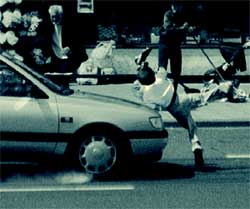 |
how much further does it take to stop ?
Risk curve - alcohol
 |
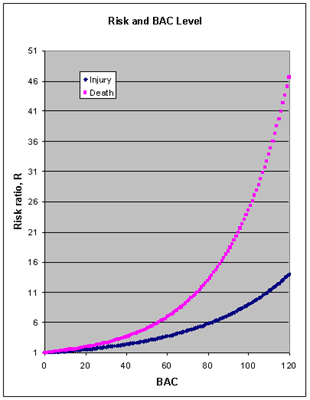 |
Measures to reduce Drink Driving
- different combinations between countries
| Sweden | Britain | Netherlands | |
|---|---|---|---|
| BAC limit | Low | High | Medium |
| Enforcement Rate | High | Low/medium | Medium |
| Penalty in Court | Low | High | Low |
Risk curve - speeding
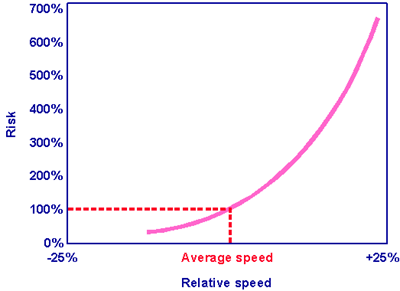
Risk curve - speed and alcohol
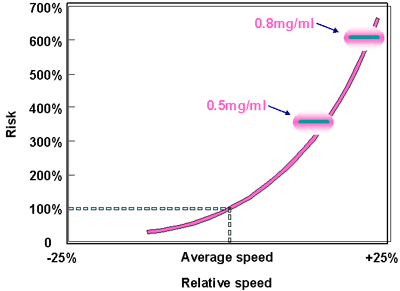
Risk curves - speeding by road type
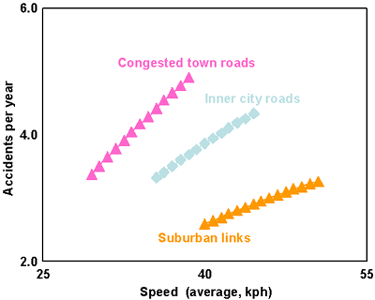
Speed camera enforcement
| Reductions in average speed | 9kph | 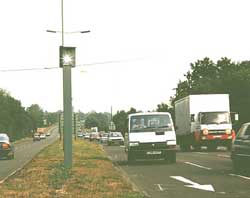 |
| Reduction in accidents | >33% | |
| Deaths & serious injury reduction | 〜50% |
Speed management - by minimum costs
Speeds associated with minimum costs for different road groups
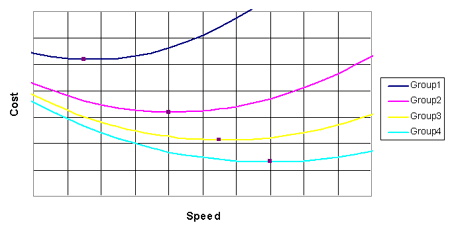
Driver improvement courses
Drivers attending drink drive courses have fewer reconvictions, especially within 12 months of their suspension. Other convicted drivers continue to drive unlicensed.
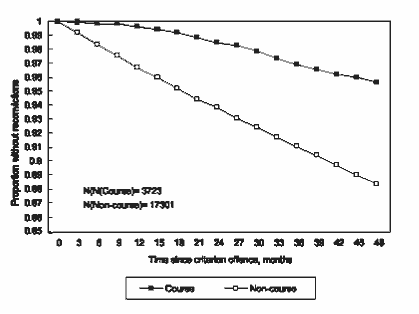
Control through intelligent systems
Speed and alcohol control systems
| Intelligent speed adaptation |  |
| Alcohol interlocks | 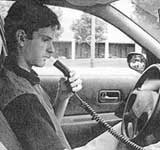 |
Issues with direct control systems
Managing the effects of new technology - assessing effect of mobile phones
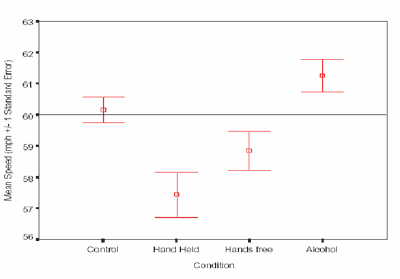 |
Drivers adopt lower speeds when using the phone … |
| …but reaction times can be longer than when impaired by alcohol | 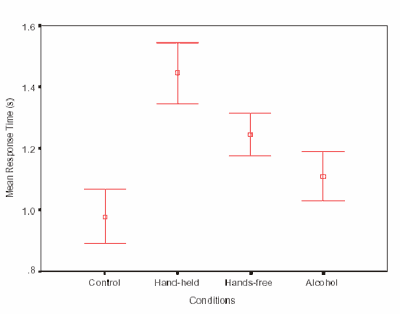 |
System model of behaviour
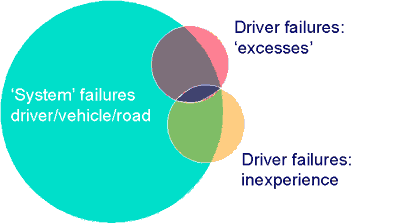
Maintaining low drink driving violations
Trend in numbers of casualties in drink drive accidents
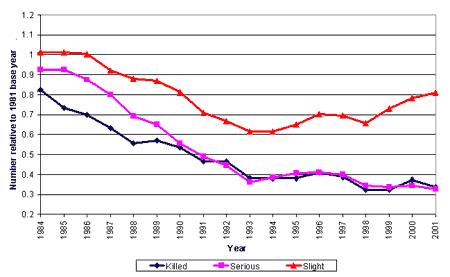
Responsibilities and expectations when the system is controlled
Dialogue with road users
| ・Urban safety management (DUMAS) - process for involving public in decisions |  |
| ・Inter-urban roads (EuroRAP) - representing individual and collective risks | 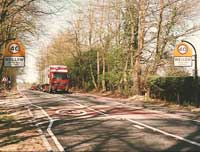 |
Target monitoring in Britain
- Fatalities and serious injuries
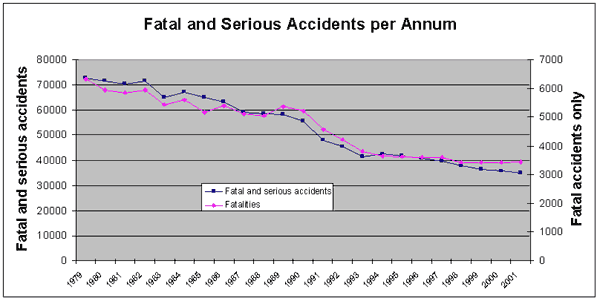
Factors limiting reduction in fatalities in Britain
Scope for casualty savings
- by policy type
| Sweden | Britain | Netherlands | |
| Vehicle improvements | 20 (including ITS contribution) |
35 (including improved motorcycle helmets) |
26 (including ITS contribution) |
| Road engineering, and speed management | 59 (including traffic control) |
44 | 50 |
| Behaviour excluding speed enforcement | 15 (novice drivers, enforcement) |
16 (novice drivers, drinking drivers, high mileage drivers) |
24 (novice drivers, enforcement) |
| Other measures | 6 (emergency care) |
5 (child safety) |
- |
![]()